Related Research Articles
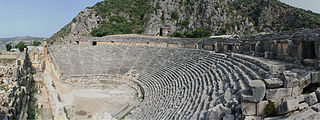
Myra was a Lycian, then captured by ancient greece and lived under their rule, then western roman empire and then Ottoman town in Lycia, which became the small Turkish town of Kale, renamed Demre in 2005, in the present-day Antalya Province of Turkey. It was founded on the river Myros, in the fertile alluvial plain between Alaca Dağ, the Massikytos range and the Aegean Sea.

Saint Nicholas of Myra, also known as Nicholas of Bari, was an early Christian bishop of Greek descent from the maritime city of Patara in Anatolia during the time of the Roman Empire. Because of the many miracles attributed to his intercession, he is also known as Nicholas the Wonderworker. Saint Nicholas is the patron saint of sailors, merchants, archers, repentant thieves, children, brewers, pawnbrokers, toymakers, unmarried people, and students in various cities and countries around Europe. His reputation evolved among the pious, as was common for early Christian saints, and his legendary habit of secret gift-giving gave rise to the traditional model of Santa Claus through Sinterklaas.

Catherine of Alexandria, also spelled Katherine is, according to tradition, a Christian saint and virgin, who was martyred in the early fourth century at the hands of the emperor Maxentius. According to her hagiography, she was both a princess and a noted scholar who became a Christian around the age of 14, converted hundreds of people to Christianity and was martyred around the age of eighteen. More than 1,100 years after Catherine's martyrdom, Joan of Arc identified her as one of the saints who appeared to and counselled her.

Petroc or Petrock was a British prince and Christian saint.

Saint Demetriusof Thessalonica, also known as the Holy Great-Martyr Demetrius the Myroblyte, was a Greek Christian martyr of the early 4th century AD.
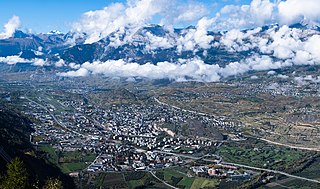
Sion is a Swiss town, a municipality, and the capital of the canton of Valais and of the district of Sion. As of December 2020 it had a population of 34,978.
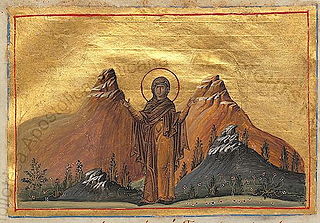
Thecla was a saint of the early Christian Church, and a reported follower of Paul the Apostle. The earliest record of her life comes from the ancient apocryphal Acts of Paul and Thecla.

Menas of Egypt, a martyr and wonder-worker, is one of the most well-known Coptic saints in the East and the West, due to the many miracles that are attributed to his intercession and prayers. Menas was a Coptic soldier in the Roman army martyred because he refused to recant his Christian faith. The common date of his commemoration is November 11, which occurs 13 days later on the Julian calendar.
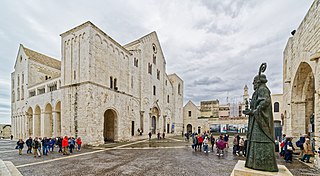
The Pontifical Basilica of Saint Nicholas is a church in Bari, southern Italy, that holds wide religious significance throughout Europe and the Christian world. The basilica is an important pilgrimage destination both for Roman Catholics and Orthodox Christians.

Hosios Loukas is a historic walled monastery situated near the town of Distomo, in Boeotia, Greece. Founded in the mid-10th century, the monastery is one of the most important monuments of Middle Byzantine architecture and art, and has been listed on UNESCO's World Heritage Sites since 1990, along with the monasteries of Nea Moni and Daphnion.

Melor was a 10th-century Breton saint who, in England, was venerated in Cornwall and at Amesbury Abbey, Wiltshire, which claimed some of his relics.

Saint Nicholai's icon labels the light house at the tip of the outskirt pier of the Port of Varna. Saint Nicholai is patron saint of sailors, fishermen, ships and sailing. In centuries of Greek folklore, Nicholas was seen as "The Lord of the Sea", often described by modern Greek scholars as a kind of Christianised version of Poseidon.

In Christianity, the translation of relics is the removal of holy objects from one locality to another ; usually only the movement of the remains of the saint's body would be treated so formally, with secondary relics such as items of clothing treated with less ceremony. Translations could be accompanied by many acts, including all-night vigils and processions, often involving entire communities.
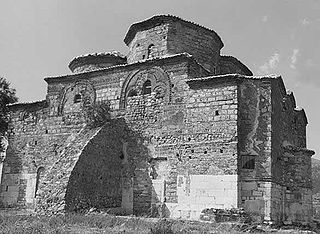
St. Nicholas Monastery Church is the katholikon of the abandoned Orthodox monastery of Saint George in Mesopotam, Vlorë County, Albania.

St. Nicholas Church is an ancient East Roman basilica church in the ancient city of Myra, now a museum located in modern Demre, Antalya Province, Turkey. It was built above the burial place of St Nicholas, a 4th-century Christian bishop of Myra, an important religious figure for Eastern Orthodox Christians and Roman Catholics and the historical inspiration for Santa Claus. Its use dated from its 6th century construction for the state church of the Roman Empire by Justinian the Great. The basilica is on UNESCO's tentative list to become a World Heritage Site.

Saint Sava, known as the Enlightener, was a Serbian prince and Orthodox monk, the first Archbishop of the autocephalous Serbian Church, the founder of Serbian law, and a diplomat. Sava, born as Rastko Nemanjić, was the youngest son of Serbian Grand Prince Stefan Nemanja, and ruled the appanage of Zachlumia briefly in 1190–92. He then left for Mount Athos, where he became a monk with the name Sava (Sabbas). At Athos he established the monastery of Hilandar, which became one of the most important cultural and religious centres of the Serbian people. In 1219 the Patriarchate exiled in Nicea recognized him as the first Serbian Archbishop, and in the same year he authored the oldest known constitution of Serbia, the Zakonopravilo nomocanon, thus securing full religious and political independence. Sava is regarded as the founder of Serbian medieval literature.

December 5 - Eastern Orthodox liturgical calendar - December 7
Mastaura was a town in ancient Lycia and is not to be confused with Mastaura (Caria).

The Rakovica Monastery is the monastery of the Serbian Orthodox Church, within the Archbishopric of Belgrade and Karlovci, located in the municipality of Rakovica in Belgrade, the capital of Serbia. It is dedicated to the archangels Michael and Gabriel.
References
- ↑ "Record | The Cult of Saints". csla.history.ox.ac.uk. Retrieved 2024-04-21.
- 1 2 3 Kazhdan, Alexander; Ševčenko, Nancy Patterson (2005-01-01). "Nicholas of Sion". The Oxford Dictionary of Byzantium. Oxford University Press. ISBN 978-0-19-504652-6 . Retrieved 2018-07-25.
- 1 2 Talbot, Alice-Mary (2008-10-23). "Hagiography". The Oxford Handbook of Byzantine Studies. doi:10.1093/oxfordhb/9780199252466.013.0082 . Retrieved 2018-07-25.